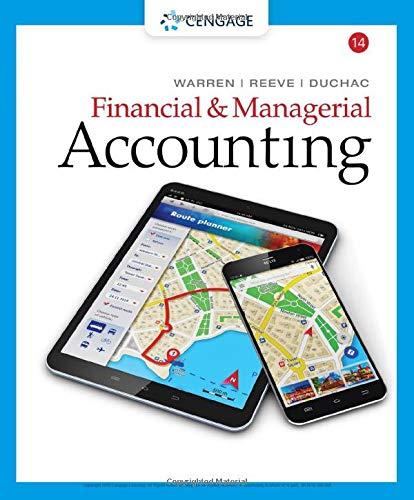For the past several years, Jeff Horton has operated a part-time consulting business from his home. As
Question:
For the past several years, Jeff Horton has operated a part-time consulting business from his home. As of April 1, 2018, Jeff decided to move to rented quarters and to operate the business, which was to be known as Rosebud Consulting, on a full-time basis. Rosebud entered into the following transactions during April:
Apr. 1. T he following assets were received from Jeffff Horton in exchange for common stock: cash, $20,000; accounts receivable, $14,700; supplies, $3,300; and office equipment, $12,000. There were no liabilities received.
1. Paid three months' rent on a lease rental contract, $6,000.
2. Paid the premiums on property and casualty insurance policies, $4,200.
4. Received cash from clients as an advance payment for services to be provided and recorded it as unearned fees, $9,400.
5. Purchased additional office equipment on account from Smith Office Supply Co., $8,000.
6. Received cash from clients on account, $11,700.
10. Paid cash for a newspaper advertisement, $350.
12. Paid Smith Office Supply Co. for part of the debt incurred on April 5, $6,400.
12. Recorded services provided on account for the period April 1-12, $21,900.
14. Paid receptionist for two weeks' salary, $1,650.
Record the following transactions on Page 2 of the journal:
17. Recorded cash from cash clients for fees earned during the period April 1-16, $6,600.
18. Paid cash for supplies, $725.
20. Recorded services provided on account for the period April 13-20, $16,800.
24. Recorded cash from cash clients for fees earned for the period April 17-24, $4,450.
26. Received cash from clients on account, $26,500.
27. Paid receptionist for two weeks' salary, $1,650.
29. Paid telephone bill for April, $540.
30. Paid electricity bill for April, $760.
30. Recorded cash from cash clients for fees earned for the period April 25-30, $5,160.
30. Recorded services provided on account for the remainder of April, $2,590.
30. Paid dividends, $18,000.
Instructions
1. Journalize each transaction in a two-column journal starting on Page 1, referring to the following chart of accounts in selecting the accounts to be debited and credited. (Do not insert the account numbers in the journal at this time.)
11 Cash ................................ 31 Common Stock
12 Accounts Receivable ..............32 Retained Earnings
14 Supplies .................................... 33 Dividends
15 Prepaid Rent ........................... 41 Fees Earned
16 Prepaid Insurance .................. 51 Salary Expense
18 Office Equipment ................. 52 Supplies Expense
19 Accumulated Depreciation ........... 53 Rent Expense
21 Accounts Payable ........... 54 Depreciation Expense
22 Salaries Payable ................. 55 Insurance Expense
23 Unearned Fees .............. 59 Miscellaneous Expense
2. Post the journal to a ledger of four-column accounts.
3. Prepare an unadjusted trial balance.
4. At the end of April, the following adjustment data were assembled. Analyze and use these data to complete parts (5) and (6).
(A) Insurance expired during April is $350.
(B) Supplies on hand on April 30 are $1,225.
(C) Depreciation of office equipment for April is $400.
(D) Accrued receptionist salary on April 30 is $275.
(E) Rent expired during April is $2,000.
(F) Unearned fees on April 30 are $2,350.
5. (Optional) Enter the unadjusted trial balance on an end-of-period spreadsheet and complete the spreadsheet.
6. Journalize and post the adjusting entries. Record the adjusting entries on Page 3 of the journal.
7. Prepare an adjusted trial balance.
8. Prepare an income statement, a retained earnings statement, and a balance sheet.
9. Prepare and post the closing entries. Record the closing entries on Page 4 of the journal. (Income Summary is account #34 in the chart of accounts.) Indicate closed accounts by inserting a line in both the Balance columns opposite the closing entry.
10. Prepare a post-closing trial balance.
Accounts PayableAccounts payable (AP) are bills to be paid as part of the normal course of business.This is a standard accounting term, one of the most common liabilities, which normally appears in the balance sheet listing of liabilities. Businesses receive... Accounts Receivable
Accounts receivables are debts owed to your company, usually from sales on credit. Accounts receivable is business asset, the sum of the money owed to you by customers who haven’t paid.The standard procedure in business-to-business sales is that...
Step by Step Answer:

Financial And Managerial Accounting
ISBN: 9781337119207
14th Edition
Authors: Carl S. Warren, James M. Reeve, Jonathan Duchac





